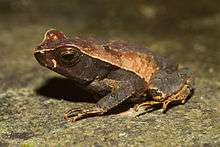Rhaebo
Rhaebo is a genus of true toads, family Bufonidae,[1][2][3] from Central and South America. They are distributed from Honduras to northern South America including the Amazonian lowlands. Common name Cope toads has been suggested for them.[1]
| Rhaebo | |
|---|---|
 | |
| Rhaebo haematiticus, the type species | |
| Scientific classification | |
| Kingdom: | Animalia |
| Phylum: | Chordata |
| Class: | Amphibia |
| Order: | Anura |
| Family: | Bufonidae |
| Genus: | Rhaebo Cope, 1862 |
| Type species | |
| Bufo haematiticus Cope, 1862 | |
| Diversity | |
| 13 species (see text) | |
| Synonyms | |
|
Phrynomorphus Fitzinger, 1843—preoccupied by Phrynomorphus Curtis, 1831 (insect) | |
Taxonomy
The genus was removed from the synonymy of Bufo in 2006; an alternative view has been to treat it as a subgenus of Bufo.[1] At present, it is widely recognized as a genus.[1][3][2][4]
Andinophryne, consisting of three species, was recognized as a separate genus until 2015 when it was found out that its recognition rendered Rhaebo paraphyletic.[1][4] An alternative to synonymizing it with Rhaebo would have been to erect a new genus for Rhaebo nasicus, but this would have caused difficulty in assigning species without molecular data to correct genus.[4]
Description
Rhaebo are characterized as lacking cephalic crests, having omosternum, distinctively wide sphenethmoid, prominent and notched exoccipital condyles, and yellowish-orange skin secretions. It is not clear which of these characters are ancestral and which are derived (i.e., synapomorphies).[4]
Species
There are 13 species in this genus:[1][2]
- Rhaebo andinophrynoides Mueses-Cisneros, 2009
- Rhaebo atelopoides (Lynch and Ruiz-Carranza, 1981)
- Rhaebo blombergi (Myers and Funkhouser, 1951)
- Rhaebo caeruleostictus (Günther, 1859)
- Rhaebo colomai (Hoogmoed, 1985)
- Rhaebo ecuadorensis Mueses-Cisneros, Cisneros-Heredia, and McDiarmid, 2012
- Rhaebo glaberrimus (Günther, 1869)
- Rhaebo guttatus (Schneider, 1799)
- Rhaebo haematiticus Cope, 1862
- Rhaebo hypomelas (Boulenger, 1913)
- Rhaebo lynchi Mueses-Cisneros, 2007
- Rhaebo nasicus (Werner, 1903)
- Rhaebo olallai (Hoogmoed, 1985)
References
- Frost, Darrel R. (2014). "Rhaebo Cope, 1862". Amphibian Species of the World: an Online Reference. Version 6.0. American Museum of Natural History. Retrieved 17 September 2015.
- "Bufonidae". AmphibiaWeb: Information on amphibian biology and conservation. [web application]. Berkeley, California: AmphibiaWeb. 2015. Retrieved 17 September 2015.
- Vitt, Laurie J.; Caldwell, Janalee P. (2014). Herpetology: An Introductory Biology of Amphibians and Reptiles (4th ed.). Academic Press. p. 491.
- Ron, Santiago R.; Mueses-Cisneros, Jonh Jairo; Gutiérrez-Cárdenas, Paul David Alfonso; Rojas-Rivera, Alejandra; Lynch, Ryan L.; Rocha, Carlos F. Duarte; Galarza, Gabriela (2015). "Systematics of the endangered toad genus Andinophryne (Anura: Bufonidae): phylogenetic position and synonymy under the genus Rhaebo". Zootaxa. 3947 (3): 347–366. doi:10.11646/zootaxa.3947.3.3. PMID 25947741.